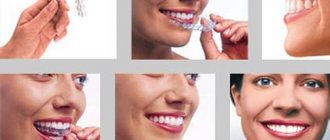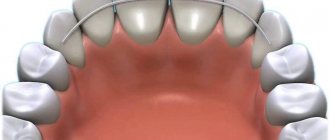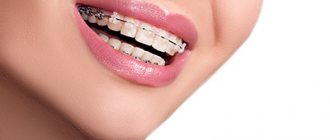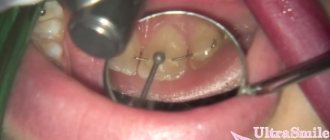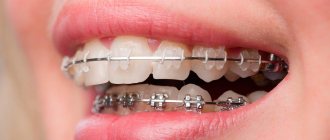Mouthguard for athletes made of silicone
Such mouthguards are used to protect teeth in contact or extreme sports - football, hockey, boxing. Sports mouthguards are worn over the front teeth and reduce the strong physical impact not only on the teeth, but also on soft tissues and even the cervical spine.
Based on manufacturing methods, there are two types of sports mouthguards:
1. Standard sports mouth guard
Sold in any sports stores, made the same for everyone.
2. Individual sports mouth guard.
It is made individually for a specific person using impressions of his teeth, taking into account their anatomical shape. They cost much more, but are also much more convenient, since they fit on the teeth “like family.”
Types of trays according to manufacturing method
In dentistry, several technologies are used to make mouthguards for teeth.
- Standard. They have the typical shape of the correct position of the dentition. Most often, such designs can be purchased immediately, rather than waiting for production. The advantage of this option is the affordable price, since standard overlays are the most budget-friendly.
- Individual. These systems are advantageous because they are tailored to the individual characteristics of the jaw structure and dentition position of the patient. The overlays are made from casts after computer modeling. The cost of such aligners is higher, but their effectiveness is higher.
- Thermoplastic. This type of construction is used more often for bite correction. The peculiarity of thermoplastic linings is that they are made of a hard material that softens under high temperature.
Based on the material used, mouthguards are divided into bioplastic and silicone. The time range for their use also differs – from a few minutes to 24 hours.
Dental mouth guard
Unlike a sports mouthguard, which is used only for impact protection, a dental mouthguard has a wider range of applications. A dental mouth guard is made from special plastic materials – silicone or polyurethane.
The convenience of the mouth guard is that it can be used to solve many problems - from therapeutic to orthodontic treatment. And at the same time, the mouthguards are convenient to use - the patient can take them off and put them on himself, according to the schedule established by the attending physician.
Price for mouthguards to correct bite
The total cost of a course of bite correction with aligners will depend on the length of treatment and the number of aligners that will need to be made. In addition to the price of the aligners themselves, it is worth considering additional procedures that may need to be performed before starting orthodontic treatment. Thus, mouthguards should not be worn if you have caries, gum disease, or poor oral hygiene. Diagnostics, photographs and casts of the jaw are paid separately. Therefore, the exact cost of a course of treatment with mouth guards to correct your bite can only be calculated for you in the orthodontist’s office.
If you are thinking about correcting your bite, come to our clinic in Moscow - “Aesthetica”! Our experienced orthodontists will definitely select the treatment method that will be most effective in your case! We offer our patients the best technologies, materials, individual approach and guarantee that with us you can treat your teeth and get a beautiful smile in a comfortable environment and without pain!
Orthodontic dental guards
These aligners are used to correct malocclusions. At the moment, there are several types of orthodontic aligners on the market from different manufacturers, including Star Smile aligners, the well-known aligners.
But not all orthodontic aligners are capable of solving serious bite problems; they only help to close the spaces between the teeth and correct minor curvatures.
Much has changed when Russian-made orthodontic mouthguards or aligners from the Star Smile company appeared; they became serious competitors to braces, since they can correct almost all defects in the development of bite.
Type No. 1: leveling
This mouthguard is used not after braces, but instead of them. It allows you to correct the position and inclination of teeth, straighten them, and correct bite pathologies, including quite serious ones. This variety can be safely called aligners, because in translation from English, align just means “to align.”
Please note that all aligners presented in orthodontics today are aligners, but calling each aligner an aligner is a mistake. Let us repeat that this only applies to teeth straightening devices.
For a patient for a course of treatment, usually not just one mouthguard is made, but a whole set or set, differing in hardness - the number in the set depends on the complexity of the initial case. As the treatment process proceeds and according to the planning scheme drawn up by the doctor, the devices from the set must be changed sequentially.
Leveling devices are much more expensive than braces, but they are distinguished by the highest aesthetics, precision of execution (made from impressions of the patient’s jaw system) and comfort, do not injure tissue during operation, do not impose restrictions on the products consumed and do not complicate oral hygiene. One of the most popular options that have proven themselves among doctors and patients is Invisalign aligners or aligners.
Every aligner is a aligner, but not every aligner is an aligner.
“Even as a teenager I was treated with braces. For a long time! But she never finished. I didn't have enough patience and desire. As a result, the teeth are crooked. Years later, I decided to return to this issue and finish the problem. But I immediately considered alternative options, because the memories of braces were painful, and I didn’t want to show them off. Then the doctor recommended transparent pads. I was pleased with the fact how long I had to wear such mouthguards after braces - in fact, treatment with them, compared to previous experiences, was much easier and more unnoticeable, the teeth straightened in about 1.5 years. I advise and recommend to everyone!” Oleo, review from woman.ru
Children's mouth guards for proper teething
These are silicone overlays for teeth, which are also called, among others. retainers, trainers. They are called teething mouthguards because they are most often used during the period of change of baby teeth to molars in children aged six to ten years.
The main purpose of teething trays or teething guides is to correct the position of the jaws and align the position of the child’s incisors during the period of early mixed dentition. They are worn for several hours during the day and all night while sleeping. The treatment period is approximately one year; during treatment, it is necessary to periodically visit an orthodontist to monitor the changes occurring.
Also, during the period of mixed dentition, children's aligners are used - children's orthodontic aligners. Since 2022, such mouthguards have been produced by the Star Smile company.
Price of a dental guard
Prices for medical mouthguards for teeth in Moscow depend on their purpose. The cost of standard mouth guards for bruxism is about 2,000 rubles, individual ones - from 5,000 rubles. The price of mouth guards for teeth straightening depends on the brand and the number of devices needed for treatment. The most expensive and most comfortable Invisalign transparent aligners cost about 200,000 rubles per set for the entire period of bite correction.
Standard whitening trays are usually sold in sets of 20 pieces at a price of 3,000 rubles. Thermoplastic trays together with a whitening gel will cost approximately 5,000 - 6,000 rubles, individual trays (created based on casts using a 3D model) with a bleaching agent - from 7,000 to 15,000 rubles.
| View | Price |
| Standard mouth guards for bruxism | From 2,000 rubles |
| Custom anti-bruxism mouthguards | From 5,000 rubles |
| Standard whitening trays | From 3,000 rubles |
| Thermoplastic trays for whitening and mineralization | From 5,000 rubles |
| Individual whitening trays | From 7,000 rubles |
| Teething trays (trainers) | From 5,000 rubles |
| Aligner trays for teeth straightening | From 100,000 rubles |
Teeth whitening trays
There are at-home teeth whitening systems that also use dental trays. Whitening trays can be customized, standard, or disposable. Before using any whitening system, you should visit your dentist to determine what is right for you and will not harm your tooth enamel.
An individual mouthguard is made personally for the patient based on impressions of his teeth. For whitening, a special gel is used that is placed inside the tray.
Whitening at home usually takes longer than at the dentist's office because the gel used at home contains less hydrogen peroxide.
The whitening procedure should be carried out strictly according to the instructions provided. The gel is placed on the inside of the mouth guard, after which the mouth guard is put on and specially pressed to distribute the gel evenly. After putting it on, rinse your mouth with water and wear the mouthguard exactly as long as the instructions say. After removing the whitening tray, you should also rinse your mouth with water.
Type No. 4: whitening
Whitening gel is placed in these transparent caps, after which they are put on the dentition - this measure allows you to isolate the product from soft tissues and eliminate the possibility of irritation, protect the active substance from external exposure to light, air and saliva, and also ensure better contact and penetration of active ingredients. components of the whitening agent into the enamel structure. Thanks to a course of using the gel with such trays, you can achieve the effect of lightening your teeth by 2-5 tones.
As a rule, they come complete with professional whitening products intended for use both in the dental office and at home. They are not only template or standard, but can also be developed individually based on casts of the patient’s jaws in a dental clinic.
Whitening tray
Applications on teeth using trays
These mouth guards are used to restore and strengthen tooth enamel. A special composition is placed inside the mouthguard, thanks to which the teeth are remineralized.
There are two types of mouth guards for dental applications – standard and thermoplastic.
Thermoplastic ones react to heat and soften when placed in hot water, and harden when put on the teeth.
Stages of making trays
Basic impressions are taken of the patient
The procedure is similar to taking an impression for dentures: an elastic material is placed on a standard impression bed for such cases, which is applied to the dentition. The resulting impression quickly hardens, and it is carefully removed, so as not to damage or disturb the picture of the impression, with the resulting dental imprint of the jaw.
Create a primary model
It is not yet made of silicone or plastic, but of plaster. Gypsum diluted with water and additives is applied to the impression, it hardens and gives an exact model of the future tire.
Product casting
Taking a cast plaster model as a basis, a silicone model is created using a hot molding machine under high pressure and temperature, which is also laminated after the process is completed.
The tire undergoes a lamination process to make its outer layers relatively rigid while maintaining softness on the side that is adjacent to the teeth and gums.
Fitting
A fitting of the splint is done, with an assessment of the patient’s well-being with it, a trial period of wear is given, then the final adjustment of the internal relief of the mouthguard is made.
Mouthguards for night teeth grinding
Bruxism or nighttime teeth grinding is one of the serious diseases that affects approximately 3% of the world's population. The reasons for this have not been fully identified, but the consequences can be very serious - from abrasion of tooth enamel to deformation of the jaw joints. Wearing special mouth guards allows you to protect your teeth from premature wear, relieve muscle tension, and reduce headaches. For the effect to be effective, the mouth guards should be worn for up to 10 hours a day.
Mouthguards for the treatment of teeth grinding are distinguished by the time of their use. There are day guards that are worn during the day; they are transparent and almost invisible.
There are night guards that you wear while you sleep. They may differ in shape from daily mouth guards, but are also comfortable and imperceptible in the mouth.
Advantages and disadvantages of mouth guards for teeth straightening
To clearly evaluate all the pros and cons of aligners for correcting the position of teeth, we will compare the main factors in the following table:
| Advantages | Flaws |
| Predictability of the final result | High price |
| No discomfort, impaired diction, metallic taste, or injury to the oral mucosa when worn | Need to remove when eating |
| Aesthetic appeal (invisibility to others) | Inability to correct complex bite defects |
| Does not violate the integrity of tooth enamel | Lack of the desired effect if the orthodontist’s recommendations are not followed in good faith |
| There are no conditions for the proliferation of pathogenic microflora | |
| Simple hygienic care | |
| No need to give up any foods |
From the information given in the table, we can conclude that there are more advantages to treatment with aligners than disadvantages.
Retainer or mouthguard
After aligning the bite using braces or aligners, you must wear a special mouth guard or retainer that secures the result. In appearance, this tray looks like an aligner, only very, very smooth and even.
Retention aligners are made from special biopolymers; they are easy to use and almost invisible. These mouth guards are worn at night and worn for several hours during the day. The timing of wearing retainers is individual and depends on the degree of development of the malocclusion.
Wearing retaining trays after braces and aligners is mandatory, and this is the only way you can be sure that the teeth will not return to their original incorrect position.
What is a mouthguard
Translated from German, the word kappe means “case, cap.” This is roughly what the device looks like – like an overlay. It is created from a fairly flexible silicone or plastic material, is tightly fixed to the entire dentition, and, if necessary, can be easily removed from the mouth at any time.
What we should know about mouthguards
Depending on the purpose, it can have different hardness and differ in appearance, it can be transparent or colored, and can be fixed simultaneously on both rows of teeth or only on one. It is important to understand that a mouthguard is a general concept, but what it is intended for and what it is like in dentistry, we will tell you further.
Luminous decorative burls
Here manufacturers have a wide range of options, as they say - for every taste and color. And even light, which, thanks to technology, is now built into mouth guards.
Of course, in this case we are not talking about the benefits of mouth guards, but about entertainment. You can wear them to a disco or surprise others at a friendly party.
Type No. 5: remineralizing
In appearance and purpose, this option is exactly the same as the previous one, only in this case it is not a whitening composition that is placed in the trays, but ones that strengthen the enamel, increase its resistance to caries and destructive external influences, and reduce sensitivity - based on fluoride, calcium and others minerals.
Remineralizing therapy or fluoridation is carried out one-time or in courses. Place of procedure: both in the dental office and at home. Mouthguards can be disposable or reusable, standard or individually designed, and even thermoplastic (you can order these on the Internet, but doctors do not recommend it, because this option can do more harm than good).
How to care for your mouthguards
Typically, mouthguards do not require special care. Modern dental mouth guards often just need to be rinsed with running water. Less often they need to be cleaned with toothpaste and a brush. When using orthodontic aligners, the doctor will definitely advise you on how to care for them.
Sports mouthguards require slightly different care and are stored in separate containers and periodically placed in a special solution to extend their life. Any sports mouthguard comes with its own instructions for use and care.
Application trays have their own service life and, as a rule, are not designed for long-term use.
It is enough to wash decorative mouth guards after use under running water, or, in extreme cases, with soap or brush them with a toothbrush.
How are aligners different from braces?
Both mouthguards and braces are used to correct bites in adults and children, but these designs have significant differences that determine both the disadvantages and advantages of each of them. To make it easier for patients to navigate in choosing the appropriate correction method, below is a table with a comparative analysis of both systems.
Aligners or braces
Table. Mouth guards and braces: comparison.
| Characteristics | Mouthguards | Braces |
| The effectiveness of bite correction | Effective only for minor bite pathologies. | Can be used for severe deformation of the dental system (including severe and complicated cases). |
| Wearing period | From 8-10 months to 2 years. | From 1 year to 2-3 years. |
| Possibility of use in childhood | Can be used in childhood (treatment of bruxism using silicone teethers is especially common). | It is acceptable to use in children over 5 years of age, but the possible risks of enamel damage must be taken into account. |
| Visibility to others | Mouthguards are made of transparent silicone or bioplastic and are practically invisible on the teeth, which makes their use more comfortable and provides psychological comfort to the patient. | Vestibular braces, which are installed on the front surface of the teeth, are clearly visible to others. If these are ordinary metal braces, wearing such a design can cause emotional distress for the patient (especially children and adolescents). |
| Comfort to use | Adaptation to the aligners usually occurs almost immediately after installation. In rare cases, this process may take 3-5 days. | Nagging pain and discomfort when wearing braces can appear at any time as the teeth gradually shift. The duration of such periods can range from 2-3 days to several weeks. |
| Degree of gum trauma | Due to the soft materials, the mouthguards practically do not injure the mucous membranes and soft tissues of the oral cavity. | Braces can have a destructive effect on tooth enamel and damage the mucous membranes of the tongue, lips and gums. |
| Possibility of removal without visiting the dental office | Maybe. | Impossible. |
| Ease of hygienic care | The mouthguard can be easily removed from the mouth to clean the teeth and the structure itself, which ensures a high level of hygiene during orthodontic treatment. | The level of hygiene when using brace systems is quite low due to the inaccessibility of surfaces covered with orthodontic brackets and locks. |
| Price | From 6 to 15 thousand rubles for one mouth guard. | From 70,000 rubles. |
At first glance, it may seem that treatment with mouth guards is a cheaper option compared to braces, but this is not the case. Aligners must be changed regularly, and one set can contain up to 25-30 drops per course of treatment. The total cost of the course is usually more than 200 thousand rubles.
Diagram of the results of treatment with mouthguards
Note! Despite all the advantages of a mouthguard, it can only be used to correct minor malocclusion pathologies or therapeutic dental treatment. The final decision on the possibility of using such structures is made by the orthodontist based on the results of an X-ray examination and visual examination of the dentition.
How to purchase a mouth guard for dental protection or treatment
Standard sports mouthguards can be purchased at almost any sports store. If you are trying to find a quality product, then you should read reviews on various forums or contact a dentist to have custom mouth guards made. This is what all professional athletes do.
Mouthguards for teeth whitening and treatment of certain diseases can be purchased at the pharmacy. But before starting use, it is still better to consult an appropriate doctor to evaluate all possible treatment options and choose a safer and more effective one.
It is better to order mouth guards for teeth straightening individually from well-known and trusted manufacturers, so as not to waste money and not cause more harm to your health.
Where to buy a mouthguard for teeth?
Standard mouthguards for protecting teeth are sold in sporting goods stores; they are inexpensive and available to absolutely everyone. However, many patients ask where to order a dental guard online? There are special websites that offer various equipment and equipment for sports. According to reviews, dental guards from Aliexpress are not always of good quality.
Therefore, in order to become the owner of an individual mouthguard for any purpose, you need to contact the clinic, since they are made from personal impressions in dental laboratories or in production. In addition, the doctor will tell you how much a dental guard costs and how to use it correctly.
Where can I buy standard-sized dental trays for the treatment of bruxism or thermoplastic ones for remineralization or teeth whitening procedures? They are sold in pharmacies. But before purchasing such mouth guards, it is also necessary to consult a dentist in order to avoid the negative consequences of their incorrect use.
Protective/Sports Mouthguards
Such devices are used when playing sports of various levels of contact (martial arts, hockey, rugby and other traumatic sports).
The purpose of such mouthguards is to prevent traumatic damage to teeth, jaws and soft tissues.
There are also devices (mouthguards) that, when put on the teeth, limit the closure of the jaws, which can be advisable in the treatment of disorders of the temporomandibular joint (TMJ), involuntary grinding of teeth (bruxism), snoring, apnea (involuntary stops of breathing during sleep ) and other violations.
Mouth guards for fluoridation
The principle of using this device is similar to that described above. As the name implies, such mouth guards are used to enhance the mineralization of tooth enamel (fluoridation); Therefore, fluoride-containing preparations are used.
Before using fluoridation trays, the patient should have their teeth professionally cleaned.
Fluoridation is also a medical procedure (but involves home implementation); Therefore, it should be carried out as prescribed and under the supervision of a physician.
Care instructions
After the patient receives a mouth guard, the dentist must explain the rules for wearing and caring for the product:
- night models cannot be worn during the day;
- daytime models must be removed before brushing your teeth and eating;
- wash the structure every day in warm water and soap;
- You can’t help but dry it with a hairdryer;
- store in a special container.
Mouth guards against teeth grinding cannot be purchased in pharmacies. You can order mouthguards to prevent enamel wear in the clinic after consultation with an orthodontist. Product prices vary. Individual models cost patients from 3 to 10 thousand rubles.
An overnight dental guard is an excellent remedy for eliminating tooth enamel wear. If you want to get rid of many problems, including bruxism, you should consider visiting an orthodontist. A competent and experienced specialist will select an effective treatment regimen using individual night guards.
How much does it cost to install mouth guards?
The total cost of bite correction will depend on the number of trays used. The treatment plan is drawn up by the doctor after diagnosis, which includes:
- panoramic shot of the jaws;
- teleroentgenogram of the skull;
- making models of jaws from casts.
The more significant the deviations from the normal position of the teeth, the longer the treatment period will be. The doctor will calculate the advisability of using mouth guards and, in case of serious malocclusions, will offer alternative options - the use of braces and orthodontic devices. The most popular aligners for correcting bites are from the Invisalign brand from the international manufacturer Align Technology.
How to put on and wear a dental guard, rules of use
To use a mouthguard for a long time and without problems, it is enough to follow simple rules of care and storage:
- prepare a well-ventilated container for it (self-respecting manufacturers supply it with the product);
- choose a storage location where direct sunlight cannot penetrate;
- use the accessory only for its intended purpose, do not gnaw or bite;
- do everything to keep the plastic clean: rinse, rinse with clean water, wipe with a lint-free cloth every time after wearing.
It is important to wear the mouth guard correctly. To do this, you need to open your mouth wide, stretching your lips to the sides, place the protection on your teeth and bite. You can use this product for no more than six months. On average, you can wear a boxing mouthguard for one season. It is not recommended to use it longer - you need to prepare a new one, as the degree of protection decreases. It will also not be possible to digest a mouth guard that has spent its allotted time, since the material will begin to crumble and deform. Manufacturers write in the instructions how long you can wear a mouth guard.
Making a dental guard yourself is easy. The main thing is to give preference to a manufacturer that has proven itself in the sports market, choose a product of the appropriate size and follow the instructions. With the right approach, a high-quality mouthguard fits perfectly and provides reliable protection.
Mouthguards-retainers after braces
After removing the braces, orthodontists install a retainer, which consolidates the therapeutic effect by fixing the teeth in the correct position. These can be enclosing arch retainers, retention plates, a metal arch, as well as mouth guards or trainers.
Trainers after braces are one-piece products for night wear, made of hypoallergenic silicone. They are always made according to standard templates and are selected according to size.
Retention mouth guards are available in both standard and custom versions. Wear them throughout the day, removing them only for cleaning or when eating.
Dental mouth guards help solve aesthetic and dental problems of patients in the most gentle and gentle way. Aligners and trainers do not require grinding of teeth, do not harm tooth enamel, and are invisible when worn. The main thing is to choose the right doctor, and then the mouth guards will be selected and manufactured correctly and will bring maximum benefit.

